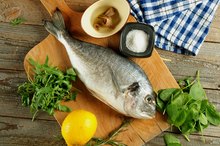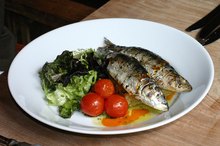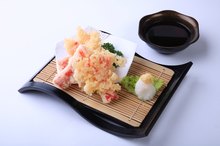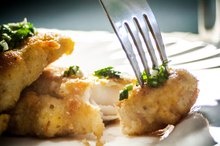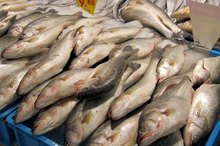Is the Sockeye Salmon a Safe Fish to Eat?
Sockeye is one of the five main species of Pacific salmon and is generally a wild-caught fish 1. All salmon are good sources of protein, vitamin B-6, vitamin B-12, niacin, riboflavin, calcium and selenium, which is a trace mineral that helps detoxify mercury. Salmon is an excellent source of vitamin D, found naturally in very few foods and an excellent source of omega-3 fatty acids. These fatty acids can lower the risk of cardiovascular disease and cancer as well as reduce tissue inflammation.
Sockeye Salmon
Sockeye salmon measure 18 to 31 inches and weigh 4 to 15 lbs. Although greenish-blue with silver flanks while in ocean waters, they turn bright red when they move upriver to spawn, giving rise to their common name of “red” salmon. Sockeye salmon live in Pacific waters off the northwest coasts of North America and Canada. Spawning occurs in rivers as far south as Oregon, but the largest populations are in Alaskan rivers and the Fraser River in British Columbia, Canada.
- Sockeye salmon measure 18 to 31 inches and weigh 4 to 15 lbs.
- Spawning occurs in rivers as far south as Oregon, but the largest populations are in Alaskan rivers and the Fraser River in British Columbia, Canada.
Farmed vs. Wild
Seafood High in Cholesterol
Learn More
All fish accumulate environmental toxins in their fat. More toxins are present in farmed salmon than most wild salmon, particularly Alaskan salmon. While wild Alaskan salmon eat fish from relatively clean waters, farmed salmon eat meal made from ground fish. The fish in the meal contain polychlorinated biphenyls, or PCBs, dioxins and pesticides from contaminated waters, and farmed salmon accumulate those contaminants in their fat. Farmers also use antibiotics on their fish.
Most farmed salmon are Atlantic salmon, but it is possible to farm other kinds. When buying sockeye, look for wild-caught Alaskan fish. Alaska has banned fish farms, but many are active in western Canada. Farms often release waste, antibiotics and chemicals into the ocean and rivers, and farmed fish sometimes escape into the wild, spreading disease and parasites. This threatens the safety of wild salmon along the coastlines of Canada and the lower 48 states.
- All fish accumulate environmental toxins in their fat.
- Most farmed salmon are Atlantic salmon, but it is possible to farm other kinds.
Mercury
Mercury leaches into ground and water from landfills, incinerators and sewage treatment facilities due to improper disposal of products containing mercury. It builds up in the muscle tissue of fish that are exposed to it as well as tissues of people who consume those fish. This is of special concern to pregnant women and children because mercury can cause neurological problems in the fetus and the growing child. Most species of wild salmon are low in mercury and considered safe to eat.
- Mercury leaches into ground and water from landfills, incinerators and sewage treatment facilities due to improper disposal of products containing mercury.
- This is of special concern to pregnant women and children because mercury can cause neurological problems in the fetus and the growing child.
Recommendations and Dietary Sources
Nutrition of Mahi Mahi Vs. White Fish
Learn More
You can remove up to 50 percent of contaminants that accumulate in salmon fat through your cooking method. Remove the skin and visible fat, then broil, grill or bake on a rack. Because mercury is retained in muscle tissue, you cannot remove it, but the selenium in salmon helps detoxify it. Because wild sockeye are naturally low in all contaminants and high in nutrients, it is safe as well as advisable to eat two to three servings per week. This is true even for pregnant women, nursing mothers and children. A serving should be approximately the size and thickness of your hand.
- You can remove up to 50 percent of contaminants that accumulate in salmon fat through your cooking method.
- Because mercury is retained in muscle tissue, you cannot remove it, but the selenium in salmon helps detoxify it.
Related Articles
References
- Alaska Department of Fish and Game; Sockeye Salmon (Oncorhynchus nerka); 2011
- Fish, salmon, Atlantic, wild, raw. FoodData Central. U.S. Department of Agriculture. Published April 1, 2019.
- Fish faceoff: Wild salmon vs. farmed salmon. Cleveland Clinic. Updated 2014.
- Graff IE, Øyen J, Kjellevold M, et al. Reduced bone resorption by intake of dietary vitamin D and K from tailor-made Atlantic salmon: A randomized intervention trial. Oncotarget. 2016;7(43):69200-69215. doi:10.18632/oncotarget.10171
- American Heart Association. Eating Fish for Heart Health. Updated March 27, 2017.
- Collins K. The best winter foods for kids. Academy of Nutrition and Dietetics. Updated 2018.
- Fish: Friend or foe?. Harvard T.H. Chan School of Public Health. Updated 2020.
- Thomas J, Thomas CJ, et al. Omega-3 fatty acids in early prevention of inflammatory neurodegenerative disease: A focus on Alzheimer's disease. Biomed Res Int. 2015;2015:172801. doi:10.1155/2015/172801
- Galasso C, Orefice I, Pellone P, et al. On the neuroprotective role of astaxanthin: New perspectives?. Mar Drugs. 2018;16(8). doi:10.3390/md16080247
- Fish allergy. American College of Allergy, Asthma & Immunology. Updated 2019.
- Crinnion WJ. The role of persistent organic pollutants in the worldwide epidemic of type 2 diabetes mellitus and the possible connection to Farmed Atlantic Salmon (Salmo salar). Altern Med Rev. 2011;16(4):301-313.
- Bergkvist C, Kippler M, Larsson SC, et al. Dietary exposure to polychlorinated biphenyls is associated with increased risk of stroke in women. J Intern Med. 2014;276(3):248-259. doi:10.1111/joim.12194
- Jeffery A. Foran, David H. Good, David O. Carpenter, M. Coreen Hamilton, Barbara A. Knuth, Steven J. Schwager, Quantitative analysis of the benefits and risks of consuming farmed and wild Salmon, The Journal of Nutrition, Volume 135, Issue 11, November 2005, Pages 2639–2643, doi: 10.1093/jn/135.11.2639
- Salmon recommendations. Monterey Bay Aquarium Seafood Watch.
- Selecting and storing fresh and frozen seafood safely. U.S. Food and Drug Administration.
Writer Bio
Laurel Heidtman began writing for her hometown paper, "The Harrison Press," in 1964. In addition to freelancing she has worked as a police officer, a registered nurse, a health educator and a technical writer. She holds an associate degree in nursing, a Bachelor of Arts in English and a Master of Technical and Scientific Communication from Miami University of Ohio.

